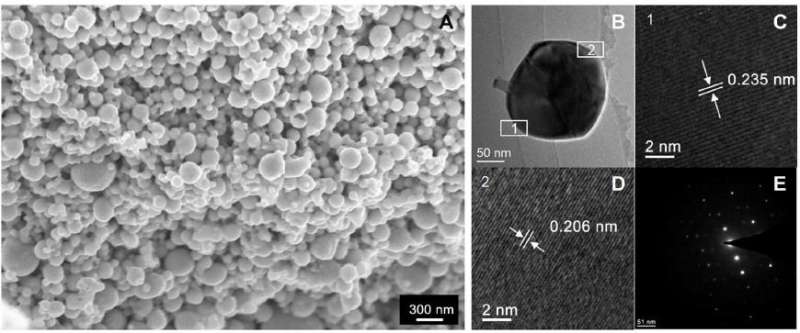August 13, 2018 report
Using tellurium nanoparticles to achieve plasmonic-like and all-dielectric properties when exposed to sunlight

A team of researchers at Sun Yat-sen University in China has created a material with dual solar properties by adding tellurium nanoparticles to water—it showed both plasmonic-like and all-dielectric properties when exposed to sunlight. In their paper published in the journal Science Advances, the group describes their material and its possible uses.
As the search for renewable resources continues, some in the field have turned to studying the possibility of adding materials to water to make it easier to produce steam for driving a turbine. Several years ago, one team of researchers discovered that adding nanoparticles to water could cause it to produce steam when exposed to sunlight. Since that time, scientists have continued experimenting with adding nanomaterials. Meanwhile, other experiments have suggested that plasmonics could play a role in photothermal conversion. In this new effort, the researchers have found a material that allows nanoparticles to offer the benefits of both approaches.
The work by the team in China was straightforward. They created nanoparticles made out of tellurium and then mixed them into a container filled with water and tested the result to see what changes it might have wrought.
The researchers report that adding the nanoparticles improved the evaporation rate by a factor of three. Testing showed that they could raise its temperature from 29°C to 85°C in just 100 seconds by shining sunlight on it. The researchers found that this improvement was possible because the nanoparticles behaved like plasmonic nanoparticles—but only when smaller sized nanoparticles (less than 120 nanometers) were involved. Nanoparticles that were larger than 120 nanometers behaved like an all-dielectric. Mixing nanoparticles of both sizes into the same container of water allowed the sample to take on both characteristics—the team claims the resultant material is the first to demonstrate both properties.
The researchers acknowledge that commercialization of their technique would be problematic because of the difficulty in manufacturing the different sized nanoparticles in sufficient quantities. They note that they are looking into ways to make them using another approach. But they also note that if they succeed, the concept has other applications, such as creating new kinds of extremely small antennas or sensors.
More information: Churong Ma et al. The optical duality of tellurium nanoparticles for broadband solar energy harvesting and efficient photothermal conversion, Science Advances (2018). DOI: 10.1126/sciadv.aas9894
Abstract
Nanophotonic materials for solar energy harvesting and photothermal conversion are urgently needed to alleviate the global energy crisis. We demonstrate that a broadband absorber made of tellurium (Te) nanoparticles with a wide size distribution can absorb more than 85% solar radiation in the entire spectrum. Temperature of the absorber irradiated by sunlight can increase from 29° to 85°C within 100 s. By dispersing Te nanoparticles into water, the water evaporation rate is improved by three times under solar radiation of 78.9 mW/cm2. This photothermal conversion surpasses that of plasmonic or all-dielectric nanoparticles reported before. We also establish that the unique permittivity of Te is responsible for the high performance. The real part of permittivity experiences a transition from negative to positive in the ultraviolet-visible–near-infrared region, which endows Te nanoparticles with the plasmonic-like and all-dielectric duality. The total absorption covers the entire spectrum of solar radiation due to the enhancement by both plasmonic-like and Mie-type resonances. It is the first reported material that simultaneously has plasmonic-like and all-dielectric properties in the solar radiation region. These findings suggest that the Te nanoparticle can be expected to be an advanced photothermal conversion material for solar-enabled water evaporation.
Journal information: Science Advances
© 2018 Phys.org



















